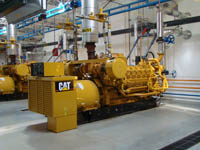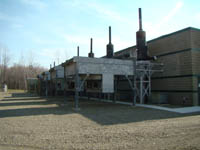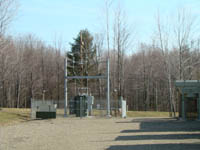Landfill Gas to Electricity
 Landfill gas is a naturally occurring byproduct of the waste thrown out every day. Each person in the United States generates about 4.5 pounds of waste per day, and more than 50% of this waste is managed in municipal solid waste landfills such as Chaffee Landfill. Organic materials disposed of in a landfill, including food, and sludge from the wastewater treatment process, help to promote the decomposition process. Landfill gas typically consists of about 50% methane (which is the primary component of natural gas) and 50% carbon dioxide, and so this gas is not very different from the natural gas that comes to your home through your local utility.
Landfill gas is a naturally occurring byproduct of the waste thrown out every day. Each person in the United States generates about 4.5 pounds of waste per day, and more than 50% of this waste is managed in municipal solid waste landfills such as Chaffee Landfill. Organic materials disposed of in a landfill, including food, and sludge from the wastewater treatment process, help to promote the decomposition process. Landfill gas typically consists of about 50% methane (which is the primary component of natural gas) and 50% carbon dioxide, and so this gas is not very different from the natural gas that comes to your home through your local utility.
 Chaffee Landfill is currently managing more than 2,000 cubic feet per minute of landfill gas. This gas is collected and removed through a series of wells located throughout the landfill. To install a gas well, special equipment is used to drill into the waste and a pipe with holes, surrounded by gravel, is inserted to collect the gas flow. The wells are all connected to a central header pipeline, where the gas is currently channeled to a flare for combustion.
Chaffee Landfill is currently managing more than 2,000 cubic feet per minute of landfill gas. This gas is collected and removed through a series of wells located throughout the landfill. To install a gas well, special equipment is used to drill into the waste and a pipe with holes, surrounded by gravel, is inserted to collect the gas flow. The wells are all connected to a central header pipeline, where the gas is currently channeled to a flare for combustion.
 With its relatively high energy content, landfill gas represents a low-cost fuel that can be used to power electrical generators. Managing this byproduct as a “green” energy source offers the opportunity to capitalize on an alternative source of electrical power.
With its relatively high energy content, landfill gas represents a low-cost fuel that can be used to power electrical generators. Managing this byproduct as a “green” energy source offers the opportunity to capitalize on an alternative source of electrical power.
With a large and growing number of beneficial-use gas projects around the country, Waste Management is a nationwide leader in turning landfill gas into electrical power. 

